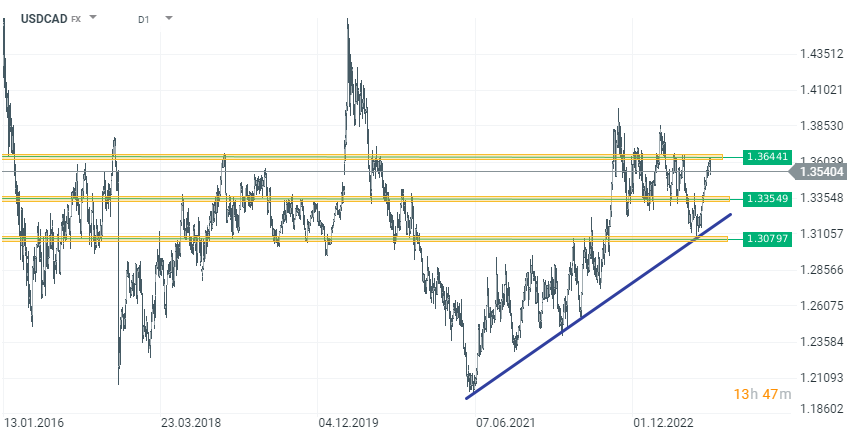- Weaker labor market data may reduce the chances for further interest rate hikes in the USA
- Higher oil prices are strengthening the Canadian dollar
- USDCAD reacted to the resistance zone, and the currency pair is currently losing
This week we've had several important macro publications from the USA, and several more are yet to come. However, data on new job openings (JOLTS) showed that the labor market is starting to weaken. A day later, we had a revision of the GDP in the USA, which turned out to be lower than previously expected. The final annualized GDP was 2.1% compared to the expected 2.4% YoY. If upcoming data for the rest of the week confirms a weakening labor market and economy, this could deepen the decline of the dollar. Worse readings increase the likelihood that the Fed will pause interest rate hikes. On the other hand, the Canadian dollar has recently been supported by high oil prices and fairly solid macroeconomic data. The Canadian economy is doing quite well, and inflation dropped to 3.3% YoY in the latest report for July.
 From a technical standpoint, USDCAD reacted to the key resistance zone around 1.365. This level has repeatedly thwarted growth in this currency pair in the past, and it was the same this time. If USDCAD returns to growth and breaks this level, we may see a sharp rise, at least in the short term—historically, USDCAD hasn't stayed above this level for long. Otherwise, if the current trend continues, the next support zones worth noting are 1.335 and 1.308, marked on the chart with a green line.
From a technical standpoint, USDCAD reacted to the key resistance zone around 1.365. This level has repeatedly thwarted growth in this currency pair in the past, and it was the same this time. If USDCAD returns to growth and breaks this level, we may see a sharp rise, at least in the short term—historically, USDCAD hasn't stayed above this level for long. Otherwise, if the current trend continues, the next support zones worth noting are 1.335 and 1.308, marked on the chart with a green line.
3 ตลาดน่าจับตาสัปดาห์นี้
ข่าวเด่น: อัตราว่างงานแคนาดาลดลง 🍁 USDCAD ร่วงแรงทันที 📉
ข่าวเด่น: GDP ยูโรโซนออกมาดีกว่าคาดเล็กน้อย! 📈 EURUSD ยังทรงตัว
ข่าวเด่น: คำสั่งซื้อภาคอุตสาหกรรมเยอรมนีเดือนตุลาคมออกมาสูงกว่าคาด ส่งผลให้ EURUSD ขยับขึ้น 📌


